Nazi Sub Found in New Jersey
 Nagle's
boat Seeker served as home base for
deep-wreck divers.
Nagle's
boat Seeker served as home base for
deep-wreck divers.
Photo © John Chatterton.
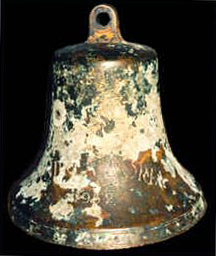 In 1985, Nagle's dive
team found the Andrea Doria's stern bell.
In 1985, Nagle's dive
team found the Andrea Doria's stern bell.
Photo © Mike Boring.
In 1991, a retired longtime deep-wreck diver named Bill Nagle, who led
a team that recovered one of the Andrea Doria's ship's bells,
was captain of the recreational deep-dive boat Seeker out of
New Jersey.
Nagle heard an intriguing tale from a friend and local charter-boat
captain: Every time the captain took a group out to an area off the
coast, all his clients caught fish. The captain knew that that was
no fluke, and told Nagle "there's something under there.”
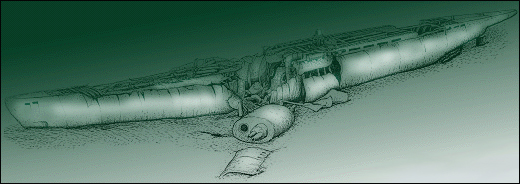 The sub as the divers found
it; its conning tower had sheered off, exposing the U-boat's
interior.
The sub as the divers found
it; its conning tower had sheered off, exposing the U-boat's
interior.
Sketch © Dan Crowell.
Curiosity got the best of Nagle, and he and some diver buddies,
including John Chatterton and Richie Kohler, organized an expedition
to the area. Sure enough, just 60 miles off the coast of New Jersey,
they found the wreck of a World War II German submarine. When the
divers checked Navy records, they found that no wreck had been
recorded for that position. That began a six-year adventure to
identify the U-boat and its crew.
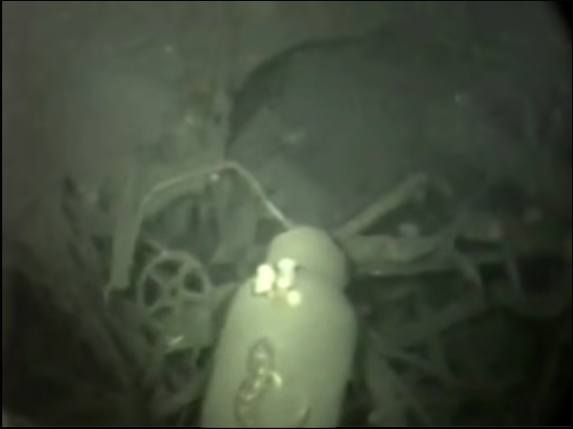 This is what the inside of
the wreck looked like on dives.
This is what the inside of
the wreck looked like on dives.
Still from Shadow Diver video © John Chatterton.
The explorers searched the sub for a hull or boat number that would
positively identify the wreck. Their dives were fraught with
danger—the sub sat in 240 feet of water (130 feet is considered a
safe deep dive), required 250 pounds of gear, decompression stops on
the way up, and scuba tanks full of a mixture of three gasses for
faster decompression. Over the course of the six-year journey, three
divers lost their lives.
Even with all that equipment, the divers could stay at the bottom
for only 30 minutes at a time. To make matters worse, the sub was
badly damaged—-to find anything that identified the sub, the divers
had to navigate a mass of cables, dislodged equipment, and sediment.
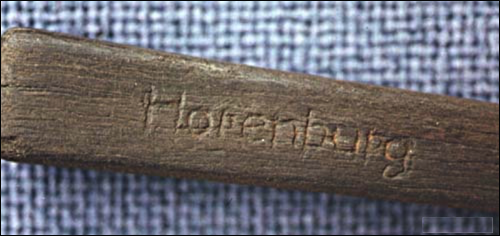 The first clue to the sub's
identity was this dinner knife, inscribed with a crew member's
name.
The first clue to the sub's
identity was this dinner knife, inscribed with a crew member's
name.
Photo © Richie Kohler.
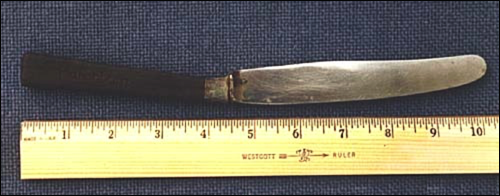 Full view of knife.
Full view of knife.
Photo © Richie Kohler.
The first clue to the boat’s identity came from an unlikely source—a
dinner knife. It had the name "Horenburg" scratched into the handle.
The divers flew to Germany to research U-boat manifests and found that
a radio operator named Martin Horenburg had been assigned to sub
U-869. But the records also showed that U-869 sank off the coast of
Gibralter, not New Jersey. Furthermore, Horenburg served on several
U-boats, and could have left the knife on any one of them. They were
back to square one.
During the off-season, the divers researched the history of
U-boats. They learned that, at the start of a patrol, spare parts
were loaded into boxes and then onto the subs. Those boxes had tags
that identified the U-boat the parts were destined for. The divers
decided to look for those tags on subsequent dives.
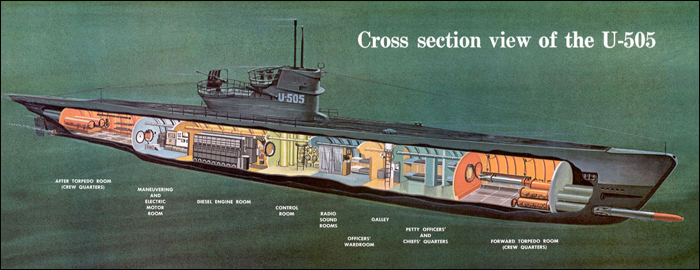 This cross-section of
U-505, a twin of U-869, shows the aft part of the sub that the
divers hadn't been able to explore because of a fallen fuel tank
(click image for an enlarged view). It included the diesel motor
room (used when surface cruising), the electric motor room (used
when submerged), and the aft torpedo room.
This cross-section of
U-505, a twin of U-869, shows the aft part of the sub that the
divers hadn't been able to explore because of a fallen fuel tank
(click image for an enlarged view). It included the diesel motor
room (used when surface cruising), the electric motor room (used
when submerged), and the aft torpedo room.
Illustration © Museum of Science and Industry, Chicago.
Up to that time, the divers had been able to explore all but the rear
of the sub—the location of the diesel and electric motor rooms, and
the aft torpedo room.
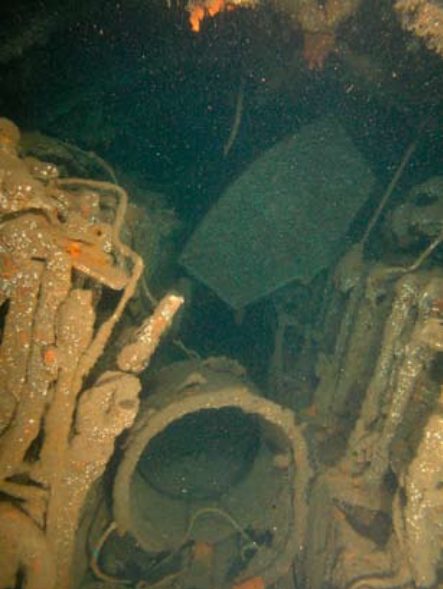 This is the diesel room on
the wreck. The engines sit on the left and right. Wedged between
them and blocking the divers' way is the oil tank that fell from
the ceiling. Chatterton went through the hole above the tank.
This is the diesel room on
the wreck. The engines sit on the left and right. Wedged between
them and blocking the divers' way is the oil tank that fell from
the ceiling. Chatterton went through the hole above the tank.
Photo © Richie Kohler.
A large oil tank, which fed the diesel engines and was normally bolted
to the ceiling, had fallen and blocked the path to those rooms. The
area below the tank was too small for a diver to get through, and the
area above it was too restricted for a diver and his gear. Their
solution? One of the divers, Chatterton, would take off his air tanks
and guide one of them into the larger, topmost space. He’d follow, and
reattach the tank on the other side. At a depth that even the Navy
considers sketchy, and with the wreck already having claimed three
lives, it was a dangerous maneuver.
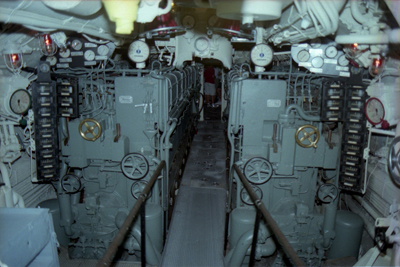 This is what the two power
plants in the diesel engine room originally looked like.
This is what the two power
plants in the diesel engine room originally looked like.
Photo © Museum of Science and Industry, Chicago.
Chatterton's first try was unsuccessful—he got through the hole all
right, but once inside, he kicked loose a pipe that landed on him.
It took his entire bottom time to extricate himself. The next day,
he made it past the obstruction, through the diesel room, and into
the electric motor room. There, near a fuse panel, Chatterton saw
boxes of spare parts. He grabbed one, handed it to dive buddy Kohler
back in the diesel room, and they surfaced.
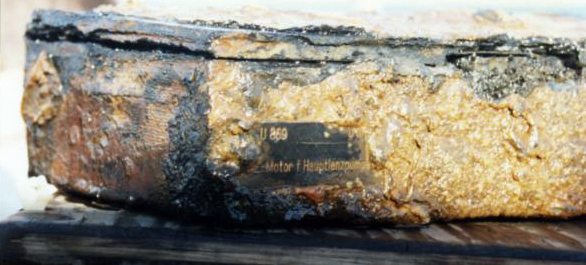 The Rosetta Stone of the
U-869. This box of spare parts held the key to the sub's identity.
The Rosetta Stone of the
U-869. This box of spare parts held the key to the sub's identity.
Photo © John Chatterton.
Back up on deck, the divers found what they'd spent six years looking
for—an identifying plate attached to the parts box. It read "U-869."
The divers finally knew the identity of the long-lost sub.
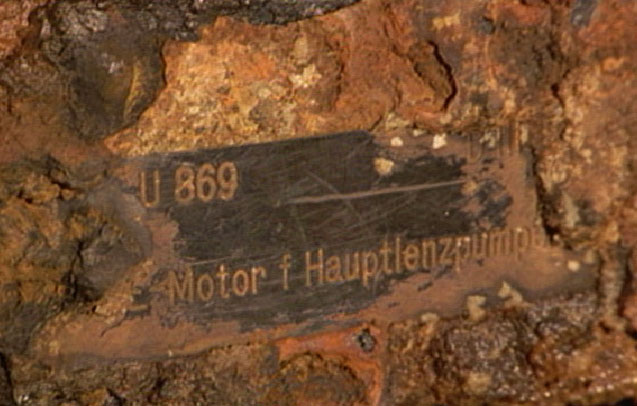 Close-up of the tag that
identified U-869. "Hauptlenzpump" translates to "main pump."
Close-up of the tag that
identified U-869. "Hauptlenzpump" translates to "main pump."
Photo © John Chatterton.
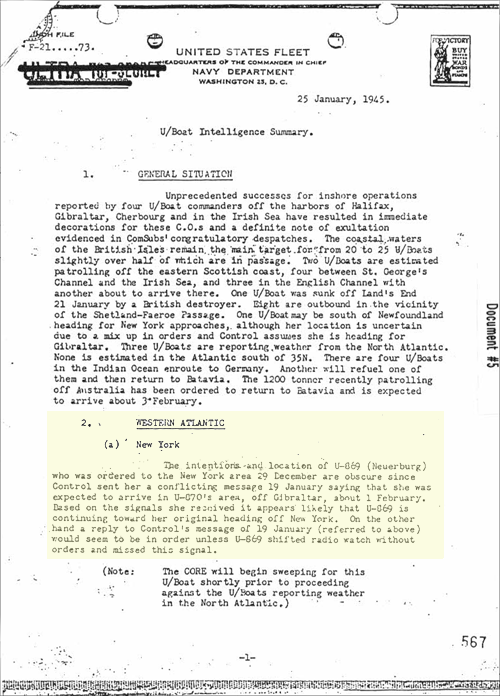 This is the Allied
surveillance report noting that U-869 had not followed orders to
change course for Gibralter. Click image to enlarge tinted area.
This is the Allied
surveillance report noting that U-869 had not followed orders to
change course for Gibralter. Click image to enlarge tinted area.
Document © U.S. Navy and John Chatterton.
So how did U-869 end up off the coast of New Jersey, and how had it
met its end?
That's where the divers and the Navy disagree. The divers felt that
U-869 had been practice-firing its torpedoes when one of the
munitions doubled back and struck the sub—torpedoes of that era
homed in on high-speed propeller noises, and in the absence of a
true moving target, the torpedo targeted U-869 itself, they
theorized.
But the Navy believes otherwise. According to Allied surveillance,
on December 29, 1944, Germany's U-Boat Command Center gave U-869 and
its crew of 56 its first—and last—orders: to patrol New York Harbor.
U-869 radioed back, acknowledging the order.
Some time after that, the Command Center worried that U-869 was
running low on fuel and redirected it to the coast of Gibraltar. But
U-869 never received those orders and continued on its way to the
east coast.
On February 11, 1945, two U.S. warships were returning to New York
Harbor when they detected a sub on their sonar. The first boat
launched underwater mortars, while the second deployed depth
charges. A few minutes later, both crews saw the signs of a hit—oil
slicks on the ocean's surface and air bubbles rising from the
depths. Sonar readings confirmed that the sub had stopped moving.
U-869 wasn't seen for the next 60 years.
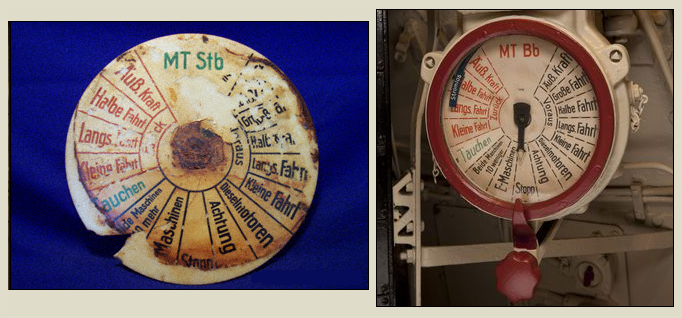 The telegraph (engine speed
control) as found on the wreck of U-869 (left) and an intact
telegraph on twin sub U-505 (right).
The telegraph (engine speed
control) as found on the wreck of U-869 (left) and an intact
telegraph on twin sub U-505 (right).
Photo © Richie Kohler (left) and Museum of Science and Industry, Chicago
(right). In addition to
Horenburg’s dinner knife (which the divers returned to his
descendants), artifacts recovered from U-869 include mechanical
equipment, dinnerware stamped with the emblem of the Third Reich,
medical supplies, and engine tags.
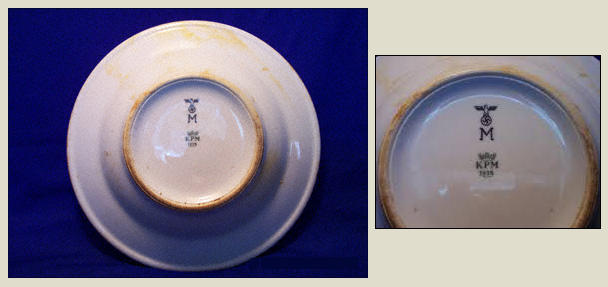 All the dinnerware on U-869
was stamped with the Parteiadler--the eagle-and-swastika emblem of
the Nazi Party.
All the dinnerware on U-869
was stamped with the Parteiadler--the eagle-and-swastika emblem of
the Nazi Party.
Photo © Richie Kohler.
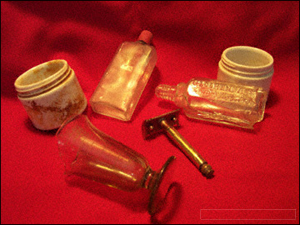 Medical supplies.
Medical supplies.
Photo © Richie Kohler.
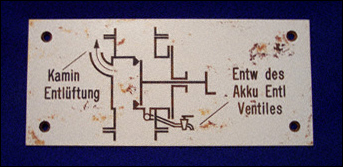 Machine plate. The left
label reads ""Fireplace ventilation," and the right one reads
"Battery drain valve." If a sub submerged at too steep an angle,
acid from the electric motor batteries could leak out.
Machine plate. The left
label reads ""Fireplace ventilation," and the right one reads
"Battery drain valve." If a sub submerged at too steep an angle,
acid from the electric motor batteries could leak out.
Photo © Richie Kohler.
The divers returned to the wreck one more time, on August 5, 2001,
to lay a memorial wreath. Diver Richie Kohler read this eulogy:
"This morning we gather here to remember the 56 fallen men of the
submarine U-869, and to honor the wishes of their families, friends,
and loved ones. We also remember the three divers who have died here
as well. We have come to mourn their loss and celebrate their lives.
We bring with us this wreath in memory of their lives and the lives
they have touched, and this ribbon in recognition of their service
and sacrifice to their countrymen."
















